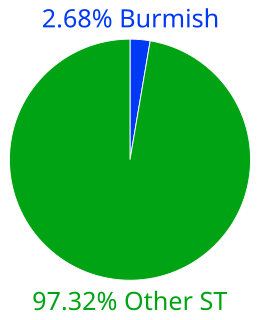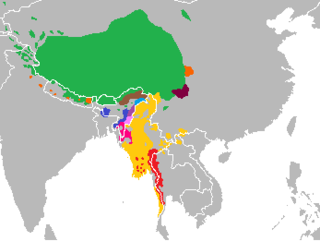Related Research Articles

Sino-Tibetan, in a few sources also known as Trans-Himalayan, is a family of more than 400 languages, second only to Indo-European in number of native speakers. The vast majority of these are the 1.3 billion native speakers of Chinese languages. Other Sino-Tibetan languages with large numbers of speakers include Burmese and the Tibetic languages. Other languages of the family are spoken in the Himalayas, the Southeast Asian Massif, and the eastern edge of the Tibetan Plateau. Most of these have small speech communities in remote mountain areas, and as such are poorly documented.

There are several hundred languages in China. The predominant language is Standard Chinese, which is based on central Mandarin, but there are hundreds of related Chinese languages, collectively known as Hanyu, that are spoken by 92% of the population. The Chinese languages are typically divided into seven major language groups, and their study is a distinct academic discipline. They differ as much from each other morphologically and phonetically as do English, German and Danish. There are in addition approximately 300 minority languages spoken by the remaining 8% of the population of China. The ones with greatest state support are Mongolian, Tibetan, Uyghur and Zhuang.
Qiangic is a group of related languages within the Sino-Tibetan language family. They are spoken mainly in Southwest China, including Sichuan, Tibet and Yunnan. Most Qiangic languages are distributed in the prefectures of Ngawa, Garzê, Ya'an and Liangshan in Sichuan with some in Northern Yunnan as well.
Jingpho or Kachin, is a Tibeto-Burman language of the Sal branch mainly spoken in Kachin State, Burma and Yunnan, China. There are many meanings for Jingpho. In the Jingpho language, Jingpho means people or Jinghpho tribe. The term "Kachin language" can refer either to the Jingpho language or to a group of languages spoken by various ethnic groups in the same region as Jingpo: Lisu, Lashi, Rawang, Zaiwa, Lhao Vo, Achang and Jingpho. These languages are from distinct branches of the highest level of the Tibeto-Burman family. The Jingpho alphabet is based on the Latin script.
The Sal languages are a branch of Sino-Tibetan languages spoken in eastern India, parts of Bangladesh, and Burma.
The Jingpho-Luish, Jingpho-Asakian, Kachin–Luic, or Kachinic languages are a group of Sino-Tibetan languages belonging the Sal branch. They are spoken in eastern India and Burma, and consist of the Jingpho language and the Luish languages Sak, Kadu, Ganan, Andro, Sengmai, and Chairel. Ethnologue and Glottolog include the extinct or nearly extinct Taman language in the Jingpo branch, but Huziwara (2016) considers it to be unclassified within Tibeto-Burman.
The Tibeto-Kanauri languages, also called Bodic, Bodish–Himalayish, and Western Tibeto-Burman, are a proposed intermediate level of classification of the Sino-Tibetan languages, centered on the Tibetic languages and the Kinnauri dialect cluster. The conception of the relationship, or if it is even a valid group, varies between researchers.
The Nung or Nungish languages are a poorly described family of uncertain affiliation within the Sino-Tibetan languages spoken in Yunnan, China and Burma. They include:

The Burmish languages are Burmese, including Standard Burmese, Arakanese and other Burmese dialects such as the Tavoyan dialects as well as non-literary languages spoken across Myanmar and South China such as Achang, Lhao Vo, Lashi, and Zaiwa.

The Tibeto-Burman languages are the non-Sinitic members of the Sino-Tibetan language family, over 400 of which are spoken throughout the highlands of Southeast Asia as well as certain parts of East Asia and South Asia. Around 60 million people speak Tibeto-Burman languages, around half of whom speak Burmese, and 13% of whom speak Tibetic languages. The name derives from the most widely spoken of these languages, namely Burmese and the Tibetic languages . These languages also have extensive literary traditions, dating from the 12th and 7th centuries respectively. Most of the other languages are spoken by much smaller communities, and many of them have not been described in detail.
Proto-Tibeto-Burman (PTB) is the reconstructed ancestor of the Tibeto-Burman languages, that is, the Sino-Tibetan languages except for Chinese. An initial reconstruction was produced by Paul K. Benedict and since refined by James Matisoff. Several other researchers argue that the Tibeto-Burman languages sans Chinese do not constitute a monophyletic group within Sino-Tibetan, and therefore that Proto-Tibeto-Burman was the same language as Proto-Sino-Tibetan.
Kadu or Kado is a Sino-Tibetan language of the Sal branch spoken in Sagaing Region, Myanmar. Dialects are Settaw, Mawkhwin, and Mawteik [extinct], with 30,000 speakers total.
Sak is a Sino-Tibetan language of the Sal branch spoken in Bangladesh and Myanmar.
Sengmai is an extinct Sino-Tibetan language of Manipur, India. It belongs to the Luish branch, and is most closely related to the Andro language of Manipur. Sengmai speakers have since shifted to Meithei.
Andro is an extinct Sino-Tibetan language of Manipur, India. It belongs to the Luish branch, and is most closely related to the Sengmai language of Manipur. Andro speakers have since shifted to Meithei.
The Luish, Asakian, or Sak languages are a group of Sino-Tibetan languages belonging to the Sal branch. They are spoken in Burma and Bangladesh, and consist of the Sak, Kadu, and Ganan languages. In recent years, Luish languages have been influenced by Burmese and Chakma.
Mruic or Mru–Hkongso is a small group of Sino-Tibetan languages consisting of two poorly attested languages, Mru and Anu-Hkongso. Their relationship within Sino-Tibetan is unclear.
Central Tibeto-Burman or Central Trans-Himalayan is a proposed branch of the Sino-Tibetan language family proposed by Scott DeLancey (2015) on the basis of shared morphological evidence.
Ganan is a Sino-Tibetan language of northwestern Myanmar. It belongs to the Luish branch, and is most closely related to the Kadu language of Myanmar.
Taman is an extinct Sino-Tibetan language that was spoken in Htamanthi village in Homalin Township, Sagaing Region, northern Myanmar. It was documented in a list of 75 words in Brown (1911). Keisuke Huziwara (2016) discovered an elderly rememberer of Taman in Htamanthi who could remember some Taman phrases as well as a short song, but was not fluent in the Taman language. However, no fluent speakers of Taman remained in the area.
References
- ↑ Hammarström, Harald; Forkel, Robert; Haspelmath, Martin, eds. (2017). "Chairel". Glottolog 3.0 . Jena, Germany: Max Planck Institute for the Science of Human History.
- ↑ McCulloch, W. (1859). Account of the Valley of Munnipore and of the Hill tribes with a comparative vocabulary of the Munnipore and other languages. Calcutta: Bengal Printing Company.
- ↑ Benedict, Paul K. (1972). Sino-Tibetan: A Conspectus (PDF). Cambridge: Cambridge University Press. p. 7. ISBN 978-0-521-08175-7.
- ↑ Matisoff, James A. 2013. Re-examining the genetic position of Jingpho: putting flesh on the bones of the Jingpho/Luish relationship. Linguistics of the Tibeto-Burman Area 36(2). 1–106.
- Huziwara, Keisuke 藤原敬介 (2014). "A new look at the classification of the Chairel language チャイレル語の系統再考." Proceedings of The Linguistic Society of Japan 日本言語学会第148 回大会予稿集, 148:272-277.
| This Sino-Tibetan languages-related article is a stub. You can help Wikipedia by expanding it. |